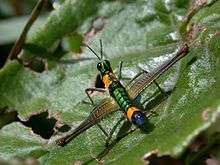Eumastacidae
| Eumastacidae | |
|---|---|
 | |
| Eumastax sp. from Colombia showing typical posture | |
| Scientific classification | |
| Kingdom: | Animalia |
| Phylum: | Arthropoda |
| Class: | Insecta |
| Order: | Orthoptera |
| Superfamily: | Eumastacoidea |
| Family: | Eumastacidae Burr, 1898 |
| Subfamilies | |
| |
Eumastacidae are a family of grasshoppers sometimes known as monkey- or matchstick grasshoppers. They usually have thin legs that are held folded at right angles to the body, sometimes close to the horizontal plane. Many species are wingless and the head is at an angle with the top of the head often jutting above the line of the thorax and abdomen. They have three segmented tarsi and have a short antenna with a knobby organ at the tip. They do not have a prosternal spine or tympanum. Most species are tropical and the diversity is greater in the Old World. They are considered primitive within the Orthoptera and feed on algae, ferns and gymnosperms, the more ancient plant groups.[1]
The families Chorotypidae and Morabidae were formerly included in this group as subfamilies but are now considered as families within the Eumastacoidea. With the exception of the central Asian Gomphomastacinae, all other subfamilies are restricted to South America.[2]
References
- ↑ Capinera, John L. (2008). Encyclopedia of Entomology. Springer. pp. 1699–1700. ISBN 9781402062421.
- ↑ S. Matt; P. K. Flook; C. H. F. Rowell (2008). "A Partial Molecular Phylogeny of the Eumastacoidea s. lat. (Orthoptera, Caelifera)" (PDF). Journal of Orthoptera Research. 17 (1): 43–55. doi:10.1665/1082-6467(2008)17[43:apmpot]2.0.co;2.